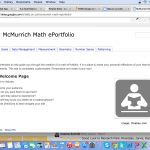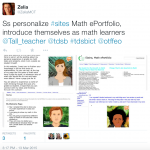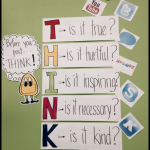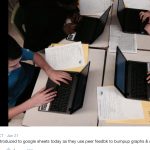Providing a more holistic and engaging math learning environment is supported by seamlessly embedding the use of technology into students everyday math program which supports the growing learning diversity within the classroom. We will continue to build upon our co-teaching, collaborative planning and moderate students work, in order to enhance our instructional practices and assessment strategies through collaborative planning and the use of technology in the math programme.
Through the availability of Chromebooks for creating math portfolios, and through student/peer collaboration, students will be able to have access to virtual/online manipulatives and various teacher-/student-generated math challenges to discuss, share, document and provide descriptive feedback within Google Sites tools (Docs, spreadsheet, drawing, slideshow).
This will allow for us as teachers to build in differentiation and allow for various entry points whereby students can record their math thinking and justify their findings/reasoning in a variety of ways.
Charp (2001) claimed that proper use of technology in the classroom improves motivation, critical thinking skills, the ability to problem-solve, and the ability to think and learn independently. Wighting (2006) found that technology can promote a sense of community which in turn leads to students’ achievement. According to the NCTM (2000), math programs should allow students to (1) organize and consolidate their math thinking through communication; (2) communicate their mathematical thinking clearly to peers, teachers and others; (3) analyze and evaluate the mathematical thinking and strategies of others; and (4) use the language of mathematics to express mathematical ideas precisely. Cooperative learning group discussions/tools such as sharing within Google apps within group digital portfolios allow for students to articulate their math understanding.
Team Members
Zelia Capitao-Tavares
Toronto District School Board
Kamla Rambaran
Toronto District School Board
Professional Learning Goals
Our goal would be to learn how to effectively implement the use of Google Sites by providing students access to tools such as Google Docs, spreadsheet and drawing as students are participating in a variety of math challenges. We want students to be engaged and drive their math learning, which enables students to link to shared peer documents within Google Sites that have been co-constructed. Thus, this environment becomes a detailed, collaborative student math portfolio.
Constructivist-based instruction is often explored in groups and the teacher role is reserved for facilitation as opposed to traditional lecturing (Schmidt, 2003). A constructivist teacher bases instruction on students interest, feedback and inquiry (Vygotsky, 1978).
Activities and Resources
- mini lessons on math concepts; using the Guides to Effective Math Instruction, exemplars from the Grade 6 EQAO provided online; workshops on using online tools
- co-create anchor charts for problem-solving strategies using the KWC model
- generate learning goals and success criteria posted in-class and within Google Classroom forum
- invite P. Singh CTO, TDSB to discuss digital citizenship
- Using EverFi online course where students learn about digital footprint, technological terms and being a responsible digital citizen
Unexpected Challenges
At the first team planning session, we revisited the goals of the TLC and what we hoped students would be able to achieve at the end of the journey. We realized that Google Sites was more conducive for students to reflect on their learning.
Google Classroom would not meet students’ needs for developing metacognition in an organized way looking at the whole student as a math learner; it was a forum more designed for assessment of learning, organization of tasks and submission of assignments. During the meeting with our Teaching & Learning with Technology Instructional Lead, we had a tour of Google Classroom, and spent time setting up the math classroom, a contact list and creating assignments, and discovered that this forum is ideal for managing documentation and assessment. Our focus needed to move to a website of which students have full creative control and permissions to customize and share their learning in their own way.
Google Sites:
siteMaestro: This online video guided in organizing a spreadsheet that would send out the Google Sites template to each student to own their own website to modify or customize. https://www.youtube.com/watch?v=EuSwkxn231o
Enhancing Student Learning and Development
Students are provided a forum in which they have a voice to build upon their math understanding, ask probing questions and reflect upon their learning. This is also extended by receiving descriptive feedback from peers and teachers to further improve upon their math thinking. Students are provided a choice to demonstrate their final findings through text, audio or video recordings when consolidating tasks within Google Sites.
Growth Portfolio:
- show growth or change over time
- help develop process skills such as self-evaluation and goal-setting
- identify strengths and weaknesses
- track and reflect on the development of my learning
- reflect on my learning
Showcase Portfolio:
- prepare a sample of best work
- showcase my favourite, best or more important work
Sharing
- We have presented at the OAME conference in 2013. Submit a proposal for the OAME 2015 conference in Barrie.
- Family of Schools meeting sharing with Beginning Teachers professional development sessions.
- TDSB ICT Marketplace April 2015 sharing forum for Teachers in TDSB by Teachers (and Students) https://docs.google.com/document/d/1SZeXeNfOk9NL8hzuHfqPSNYsy_hFWevy5q2TTvLK8Fg/edit
- Submitting a proposal for the TDSB DLL Google Camp Fall 2015 https://sites.google.com/a/tdsb.on.ca/tdsbgooglecamp/
Project Evaluation
- pre- and post-surveys will be administered using Google Forms to review students attitudes towards themselves as math learners
- various assessment as learning strategies to document the process
- small group discussions and sharing of students designed Google Sites
Resources Used
Teacher-generated template that students used as a launching point for customizing their own Math ePortfolio in Google Sites.
(co-designed with Jane Silva (Mathematics/Numeracy Instructional Leader) and Andrew Schmitt (Teaching & Learning with Technology Instructional Leader)
https://sites.google.com/a/tdsb.on.ca/mcmurrich-math-eportfolio/
Below is a student Google Site sample…
https://sites.google.com/a/tdsb.on.ca/elowyn-math-eportfolio/
Resources Created
These resources will open in your browser in a new tab, or be downloaded to your computer.













